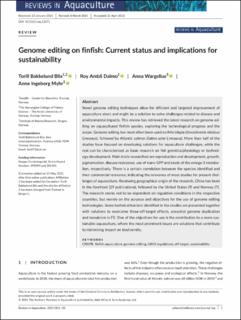| dc.description.abstract | Novel genome editing techniques allow for efficient and targeted improvement of aquaculture stock and might be a solution to solve challenges related to disease and environmental impacts. This review has retrieved the latest research on genome editing on aquacultured finfish species, exploring the technological progress and the scope. Genome editing has most often been used on Nile tilapia (Oreochromis niloticus Linnaeus), followed by Atlantic salmon (Salmo salar Linnaeus). More than half of the studies have focused on developing solutions for aquaculture challenges, while the rest can be characterized as basic research on fish genetics/physiology or technology development. Main traits researched are reproduction and development, growth, pigmentation, disease resistance, use of trans-GFP and study of the omega-3 metabolism, respectively. There is a certain correlation between the species identified and their commercial relevance, indicating the relevance of most studies for present challenges of aquaculture. Reviewing geographical origin of the research, China has been in the forefront (29 publications), followed by the United States (9) and Norway (7). The research seems not to be dependent on regulative conditions in the respective countries, but merely on the purpose and objectives for the use of genome editing technologies. Some technical barriers identified in the studies are presented together with solutions to overcome these-off-target effects, ancestral genome duplication and mosaicism in F0. One of the objectives for use is the contribution to a more sustainable aquaculture, where the most prominent issues are solutions that contribute to minimizing impact on biodiversity. | en_US |
